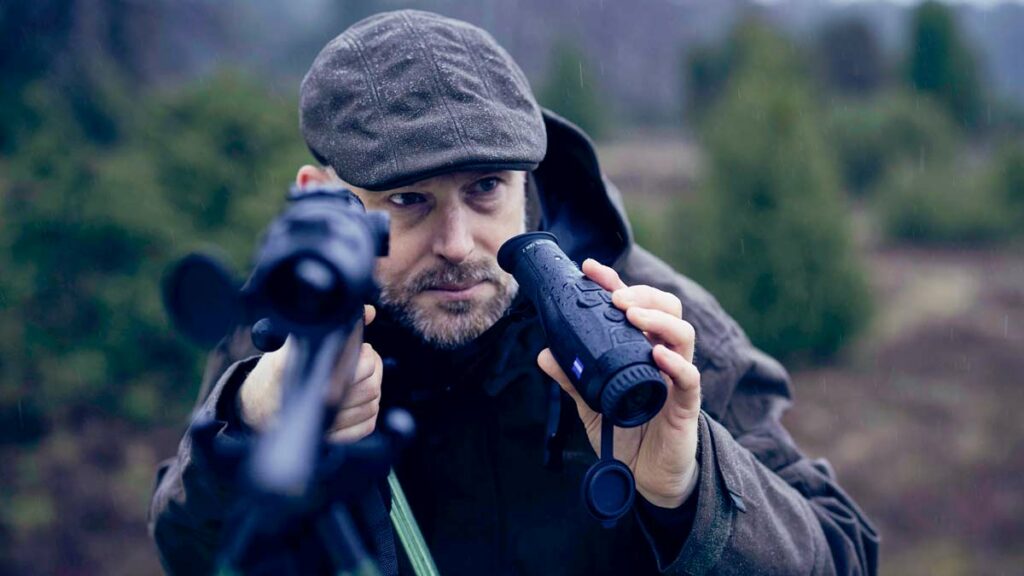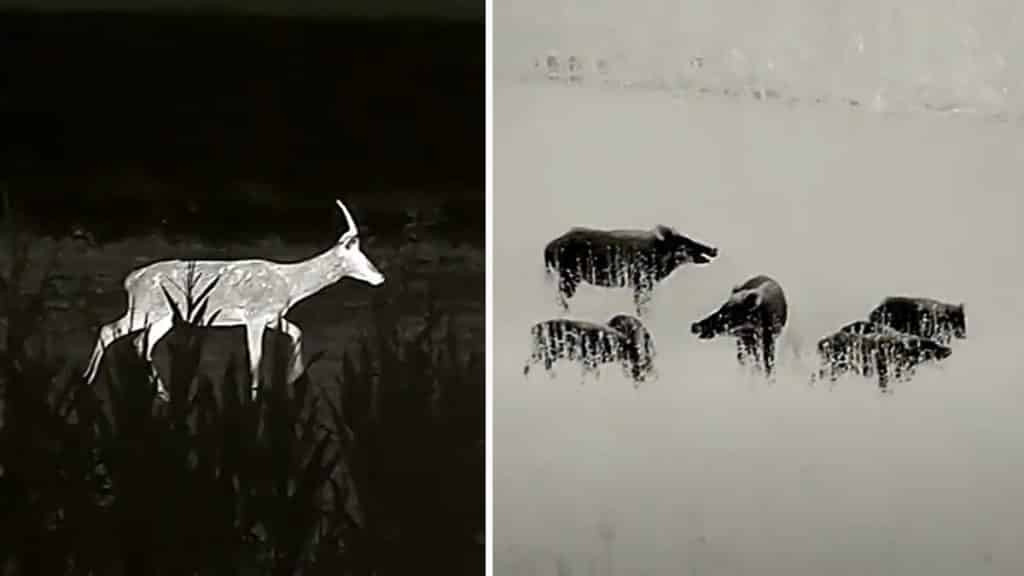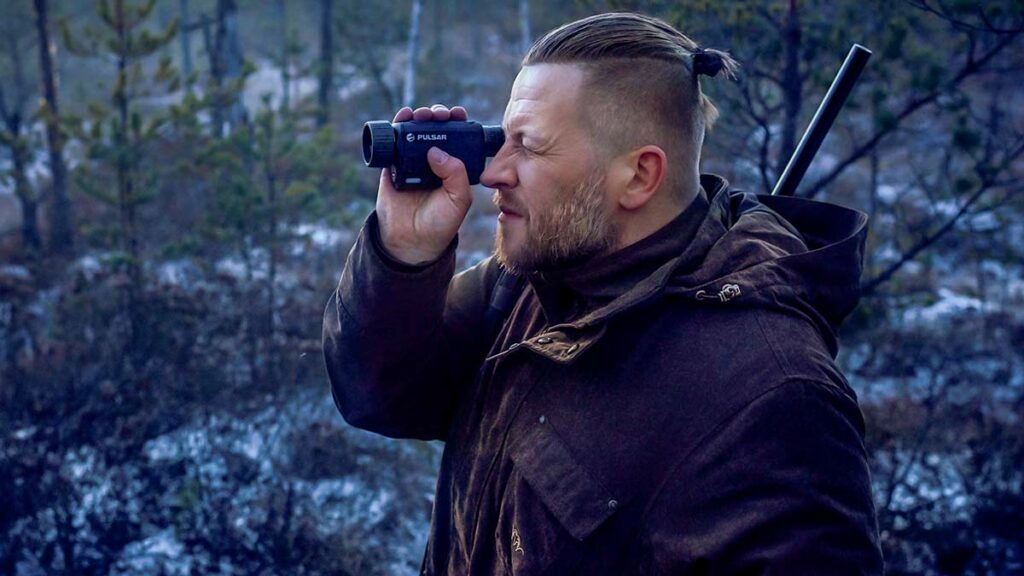Thermal vision is a technology that detects the infrared radiation emitted by bodies according to their temperature. In other words: it captures the heat emitted by bodies, both day and night, and displays it on a screen in different colors. This advantage can be very useful for hunting, as it allows us to locate and analyze animals more easily and safely, without depending on ambient light or vegetation. It also provides greater safety when shooting, especially at night, as it allows us to perfectly identify our target to avoid mistakes or accidents.
A thermal viewing monocular is a handheld device that can be used with one hand and incorporates a thermal camera, a display and a battery. Some models also have additional functions such as digital zoom, video recording or wifi connection. In addition, there are models that can be used as a complement to a conventional viewfinder and as an alternative to binoculars or thermal binoculars.
What should I look for when buying a thermal viewing monocular for hunting?
Thermal imaging devices are not exactly cheap, so it is only natural that you want to make sure that the model you buy is good enough to pay those hard-earned euros. To avoid making a mistake, you should look at seven features: resolution and sensor sensitivity, magnification and field of view, digital zoom and image stabilization, display and image type, battery and battery life, design and ergonomics, price and warranty.
1. Sensor resolution and sensitivity
The sensor of the thermal monocular is the component that captures infrared radiation and converts it into a visible image. Its sensitivity is measured in microns and determines the ability to detect small temperature differences. One of the most important aspects when choosing a monocular is the size of the built-in sensor. These can range from 160×120 pixels to 640×512 pixels. Smaller sensors are usually cheaper and lighter, but also offer lower image quality and a shorter detection range. Larger sensors are usually more expensive and heavier, but also offer higher image quality and longer sensing range.
The higher the resolution and the lower the sensitivity, the better the image quality. The screen resolution is measured in pixels and determines the sharpness and detail of the image. The sensor can also be cooled (or not).
2. Magnification and field of view
The magnification of the monocular lens is the factor that determines the size of the image in relation to the actual size of the object. The higher the magnification, the closer you can see your targets, but also the narrower the field of view. The field of view is the angle that the image encompasses and determines the extent of the scene that can be seen. The larger the field of view, the wider the image will be, but you will also be able to see more distant targets.
3. Digital zoom and image stabilization
Digital zoom is a function that allows you to enlarge the image without changing the lens. It has the advantage of bringing the subject closer without losing field of view, but has the disadvantage of reducing resolution and image quality. Image stabilization is a function that compensates for unintentional movements of the device and prevents the image from being blurred or shaky. It is very practical for observing animals, especially when they are at a long distance, as it compensates for the involuntary shaking of the hunter’s hand.

4. Display and image type
The display is the component that shows the image captured by the sensor. Its size and resolution influence the comfort and clarity of the display. It can be LCD, OLED or LCOS, each with its advantages and disadvantages in terms of brightness, contrast and power consumption. The type of image displayed can be monochromatic (black and white) or polychromatic (false colors), the user can choose each according to their preferences depending on taste and situation.
5. Battery life and autonomy
The battery is the component that powers the device and determines its autonomy or duration. Its capacity is measured in milliampere hours (mAh) and its voltage in volts (V). The higher the capacity and the lower the voltage, the longer the autonomy. The type of battery (rechargeable or disposable) and the charging system (external or internal) must also be taken into account.
6. Design and ergonomics
Design and ergonomics are aspects that influence the ease and comfort of use of the device. Consider the weight, size, shape, materials, buttons, menus, accessories and additional features. Bear in mind that you will be using it in the field, often holding it with only one hand and it will be exposed to inclement weather, so make sure it is resistant to water, dust, shocks and extreme temperatures.
7. Price and guarantee
The price you are willing to pay is something you have to set yourself. In the market you can find thermal monoculars for hunting from 400 euros and up to more than 3000 euros, depending on its characteristics, features and the place where you buy it. As in everything, the price usually goes hand in hand with the features. One thing you should pay attention to is the warranty: analyze well the time and conditions offered.

Make sure you buy from a seller authorized by the brand: on the market you can find offers from “pirate” importers who may offer the product cheaper than the official importer, but do not offer a warranty service that allows the device to be repaired free of charge. Obviously, official importers do not offer support for this type of devices that have been put on sale without any control by the brand.
As you can see, there is a wide variety of thermal monoculars for hunting, with different features and prices. The choice will depend on the needs and budget of each hunter, as well as the availability and legality of these devices in each autonomous community.
And don’t forget… to look out for the milikelvins…
Millikelvins are a very small unit of temperature measurement, equivalent to one thousandth of a kelvin. A kelvin is a unit of measurement of absolute temperature, which is based on absolute zero, the coldest possible point at which there is no molecular motion.
The image quality of thermal viewfinders depends on several factors, including the thermal resolution of the sensor. Thermal resolution is the sensor’s ability to detect small temperature differences between objects and the background. The higher the thermal resolution, the more detail can be seen in the image.
To measure the thermal resolution of a sensor, the NETD (Noise Equivalent Temperature Difference) parameter is used, which indicates the minimum temperature difference that the sensor can detect. The NETD is measured in millikelvins, i.e. thousandths of a degree. The lower the NETD, the higher the thermal resolution and the better the image quality.
For example, a sensor with a NETD of 35 millikelvins can detect a temperature difference of 0.035 degrees between two objects. A sensor with a NETD of 50 millikelvins can only detect a difference of 0.05 degrees. Therefore, the sensor with the lower NETD will have a sharper and more accurate image. Don’t forget to check before deciding to buy your monocular.

